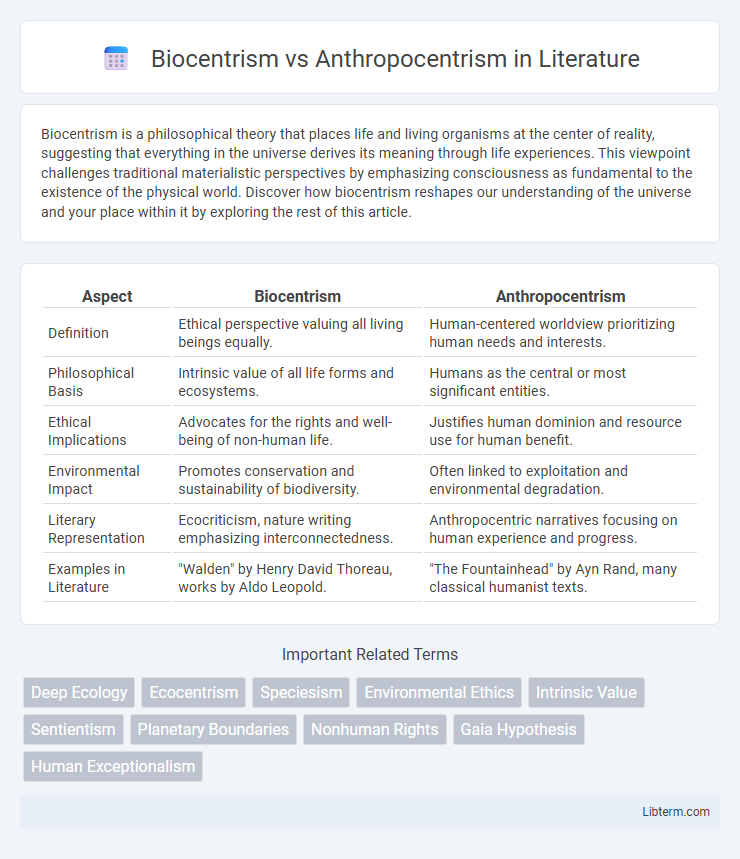Biocentrism is a philosophical theory that places life and living organisms at the center of reality, suggesting that everything in the universe derives its meaning through life experiences. This viewpoint challenges traditional materialistic perspectives by emphasizing consciousness as fundamental to the existence of the physical world. Discover how biocentrism reshapes our understanding of the universe and your place within it by exploring the rest of this article.
Table of Comparison
| Aspect | Biocentrism | Anthropocentrism |
|---|---|---|
| Definition | Ethical perspective valuing all living beings equally. | Human-centered worldview prioritizing human needs and interests. |
| Philosophical Basis | Intrinsic value of all life forms and ecosystems. | Humans as the central or most significant entities. |
| Ethical Implications | Advocates for the rights and well-being of non-human life. | Justifies human dominion and resource use for human benefit. |
| Environmental Impact | Promotes conservation and sustainability of biodiversity. | Often linked to exploitation and environmental degradation. |
| Literary Representation | Ecocriticism, nature writing emphasizing interconnectedness. | Anthropocentric narratives focusing on human experience and progress. |
| Examples in Literature | "Walden" by Henry David Thoreau, works by Aldo Leopold. | "The Fountainhead" by Ayn Rand, many classical humanist texts. |
Introduction to Biocentrism and Anthropocentrism
Biocentrism emphasizes the intrinsic value of all living organisms, arguing that humans are not superior to other species but part of a complex ecological system. Anthropocentrism places humans at the center of moral consideration, prioritizing human needs and interests above the environment and non-human life. This philosophical contrast shapes environmental ethics and influences policies on conservation and sustainability.
Core Principles of Biocentrism
Biocentrism centers on the intrinsic value of all living organisms, asserting that life itself, irrespective of species, deserves ethical consideration and respect. This philosophy rejects human superiority by emphasizing interconnectedness and equality among all forms of life, promoting a holistic ecosystem perspective. Core principles include recognizing the inherent worth of non-human life, advocating for environmental stewardship, and rejecting anthropocentric biases in moral and ecological decision-making.
Key Tenets of Anthropocentrism
Anthropocentrism centers on human beings as the most significant entities in the universe, emphasizing human interests and values above all else. It asserts that nature and other species have instrumental value primarily in relation to human needs and purposes. This worldview often justifies environmental exploitation by prioritizing economic growth and human welfare over ecological preservation.
Historical Roots and Evolution
Biocentrism emerged from early environmental ethics movements in the 19th and 20th centuries, challenging anthropocentrism's human-centered worldview rooted in Western philosophy and Judeo-Christian traditions. While anthropocentrism prioritizes human interests as central to moral consideration, biocentrism expands intrinsic value to all living beings, influenced by ecological science and deep ecology thinkers like Aldo Leopold and Arne Naess. The evolution of these paradigms reflects shifting cultural attitudes toward nature, moving from domination and resource exploitation to holistic stewardship and interspecies equality.
Ethical Implications and Moral Considerations
Biocentrism challenges anthropocentrism by valuing all living beings intrinsically rather than prioritizing human interests, altering ethical considerations in environmental and animal rights debates. It promotes moral responsibility toward ecosystems and non-human life, urging policies that protect biodiversity and recognize the interdependence of species. This shift demands reevaluation of laws and social norms to address the inherent worth of all life forms beyond human utility.
Environmental Policy and Decision-Making
Biocentrism emphasizes the intrinsic value of all living organisms, urging environmental policies that protect ecosystems and biodiversity regardless of human interests, fostering sustainability and ethical stewardship. Anthropocentrism prioritizes human needs and benefits, often shaping policies that balance environmental protection with economic development and resource exploitation. Environmental decision-making influenced by biocentrism tends to adopt stricter conservation measures, while anthropocentric frameworks frequently focus on optimizing natural resources for societal advancement.
Human-Nature Relationship Perspectives
Biocentrism asserts that all living organisms hold intrinsic value, emphasizing the interconnectedness and equal importance of humans and nature in ecological systems. Anthropocentrism prioritizes human interests and sees nature primarily as a resource for human use, often leading to exploitation and environmental degradation. These contrasting perspectives shape environmental ethics, conservation strategies, and policy-making by influencing how societies value biodiversity and ecosystem health.
Criticisms and Debates: Strengths and Weaknesses
Biocentrism faces criticism for potentially undervaluing human needs and technological progress, while its strength lies in promoting intrinsic value to all living beings, encouraging environmental ethics. Anthropocentrism is often debated for fostering human exceptionalism and environmental exploitation, though it emphasizes human welfare and pragmatic resource management. Both perspectives confront the challenge of balancing ecological preservation with human development, highlighting ongoing ethical and practical tensions in environmental philosophy.
Biocentrism and Anthropocentrism in Modern Society
Biocentrism emphasizes the intrinsic value of all living beings and ecosystems, promoting environmental ethics that prioritize biodiversity and ecological balance over human interests. In contrast, anthropocentrism places humans at the center of moral consideration, often driving policies that favor economic growth and technological development at the expense of natural habitats. Modern society faces ongoing debates between these perspectives, influencing environmental legislation, conservation efforts, and sustainable development strategies worldwide.
Future Directions and Sustainable Solutions
Future directions in biocentrism emphasize integrating ecological ethics into policy-making, promoting biodiversity conservation, and fostering intrinsic value of all life forms for sustainable environmental stewardship. Anthropocentrism-driven solutions focus on balancing human needs with ecosystem services by advancing green technologies and circular economies to reduce resource depletion and pollution. Embracing a hybrid approach can drive sustainable solutions, ensuring long-term planetary health and equitable development across human and non-human entities.
Biocentrism Infographic

 libterm.com
libterm.com